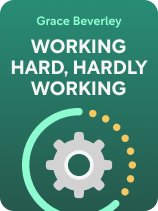

This article is an excerpt from the Shortform book guide to "Working Hard, Hardly Working" by Grace Beverley. Shortform has the world's best summaries and analyses of books you should be reading.
Like this article? Sign up for a free trial here.
Do you ever lose track of time when you’re working? What type of tasks engross you?
Grace Beverley brings productivity and self-care together in her book Working Hard, Hardly Working. She says that flow makes productivity a form of self-care because the feeling of being engrossed in a task is joyful and satisfying.
Read more to learn why a flow state at work is beneficial and how to achieve it.
Getting in a Flow State at Work
According to psychologist Mihaly Csikszentmihalyi, flow is a state in which you’re deeply absorbed in a task. Beverley contends that, when you’re in a flow state at work, you not only get more done but you also enjoy work more.
(Shortform note: Flow has additional benefits beyond providing joy and satisfaction. For example, Csikszentmihalyi says that flow can leave you feeling more confident. When you work hard during flow to apply your skills toward goals you’ve deemed worthwhile, you feel better about yourself overall.)
According to Csikszentmihalyi, you experience flow when you’re engaged in a task in which your skill level matches the level of challenge you feel. If you’re not experiencing flow because a task is too easy, you can enter flow by making the task more challenging. If you’re unable to access flow because a task is too difficult, improve your skills.
(Shortform note: To enter flow by making an easy task more challenging, try beating your personal record or setting yourself a very challenging goal. For instance, if you’re an interior decorator, aim to complete your next decoration job using half the budget of your previous job. To initiate flow by improving your skills, consider seeking out a mentor who can provide feedback and teach you new skills.)
Beverley advises that it’s easiest to enter flow states when working on tasks that are already conducive to flow. Start by identifying tasks that have put you into a state of flow before. Think of instances in which you felt completely engaged in a work task, such as moments when you lost track of time.
(Shortform note: In Flow, Csikszentmihalyi describes additional elements of a flow state—these may help you recall tasks that have put you into flow. For instance, he says tasks that induce flow are autotelic—you’re motivated to do them because the process of working on them is enjoyable, not just because you anticipate certain benefits once you’re finished. For example, if you enjoy corresponding with clients because you like socializing with them, that’s an autotelic task that’s likely to put you into a state of flow. By contrast, if you enjoy corresponding with clients only because you anticipate doing so will later increase your profits, that task is less likely to easily induce flow.)
Next, instead of waiting for flow to happen when you engage in these tasks, purposefully initiate flow. Engage in a brief warm-up activity (Beverley calls these “flow triggers”) that inspires you to work on the tasks you identified. For instance, say you’re a graphic designer who has experienced flow in the past when sketching logo ideas. You could initiate flow by looking at pictures of your favorite logos for inspiration before designing your own.
(Shortform note: To make your warm-up as inspiring as possible, consider making it playful. In The Power of Fun, Catherine Price describes playfulness as having an attitude of curiosity, openness, and willingness to experiment instead of a specific purpose or desired outcome. For example, instead of looking at pictures of your favorite logos as your warm-up, create logos for imaginary and silly companies, like a noodle company that makes unconventional noodle shapes. Price cites research suggesting that playfulness has numerous benefits: It boosts your creativity, improves your memory, and decreases stress.)
Meet Your Needs While You’re in Flow
Beverley says you can attend to your needs (physical and otherwise) while you’re in a state of flow. Even though flow is an enjoyable state, Beverley warns that it can lead to overwork. Let’s explore two of Beverley’s tips for avoiding this.
Tip 1: Prepare to Meet Your Physical Needs
When you’re experiencing flow, you might be so absorbed in a task that you forget to take care of yourself. Therefore, before starting a task that’ll get you into flow, prepare to meet your physical needs. For instance, fill your water bottle in advance and make sure your workspace is comfortable.
(Shortform note: Some experts recommend desk-based self-care strategies, like using a water bottle that includes time markings to easily show you how much water you need to consume each hour of the day. In addition to making sure your workspace is physically comfortable in advance, consider writing yourself reminders to meet your physical needs throughout your flow session. For instance, write a reminder to prevent eye strain by following the “20-20-20 rule”: Every 20 minutes, look 20 feet away from your screen for at least 20 seconds.)
Tip 2: Decide in Advance How Long to Spend in Flow
Furthermore, if you spend too much time in flow, you’ll become mentally and physically exhausted—Beverley calls this “overflow.” Therefore, set a time limit for your flow session in advance. Enforce this limit by ensuring you’ll know to stop when that time is up—for example, set up a desktop notification to remind you when your flow period has ended.
(Shortform note: Whereas Beverley recommends setting a time limit for your flow sessions in advance, other experts recommend setting a time limit for only your breaks. For instance, the Flowtime Technique has you work for as long as you want and take timed breaks whenever the need for a break arises. For example, you might take a timed break when you need to stretch your legs or when your task makes you frustrated. The technique’s creator explains that this approach has two benefits. First, by taking breaks when you need to, you’re more likely to be focused while working and thus achieve flow. Making these breaks timed ensures you don’t avoid your work for too long. Second, you won’t feel anxious about a timer interrupting your work—such anxiety could prevent you from achieving flow.)

———End of Preview———
Like what you just read? Read the rest of the world's best book summary and analysis of Grace Beverley's "Working Hard, Hardly Working" at Shortform.
Here's what you'll find in our full Working Hard, Hardly Working summary:
- Why self-care and productivity require one another
- How to use your work time wisely and make work tasks more enjoyable
- How regular self-care can help you prevent burnout






